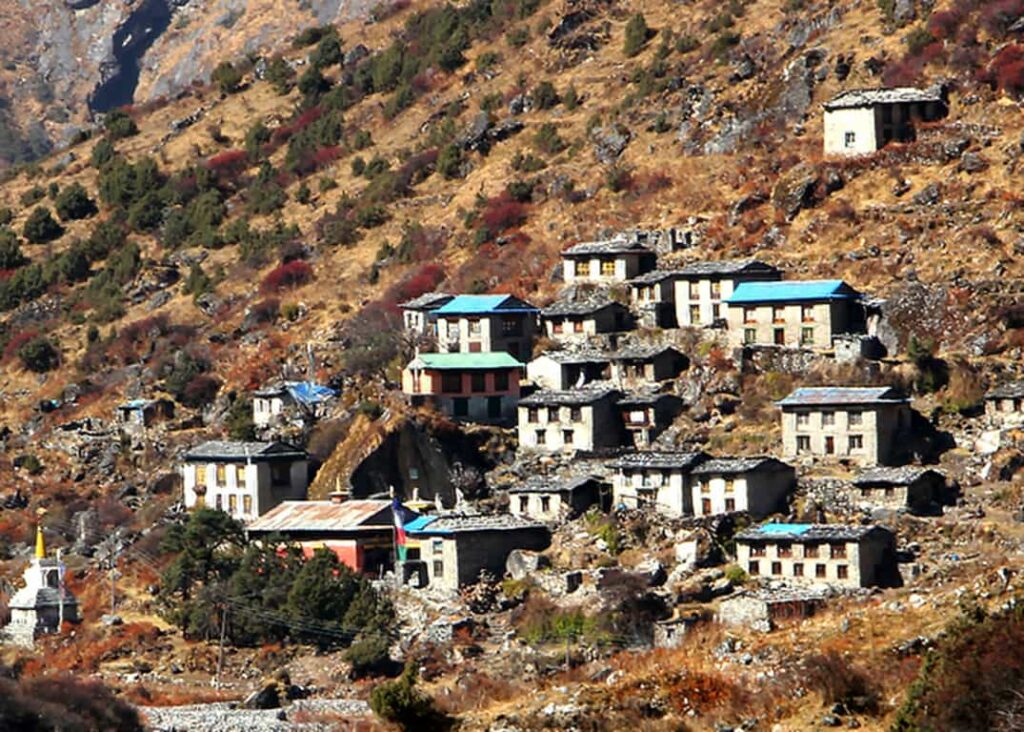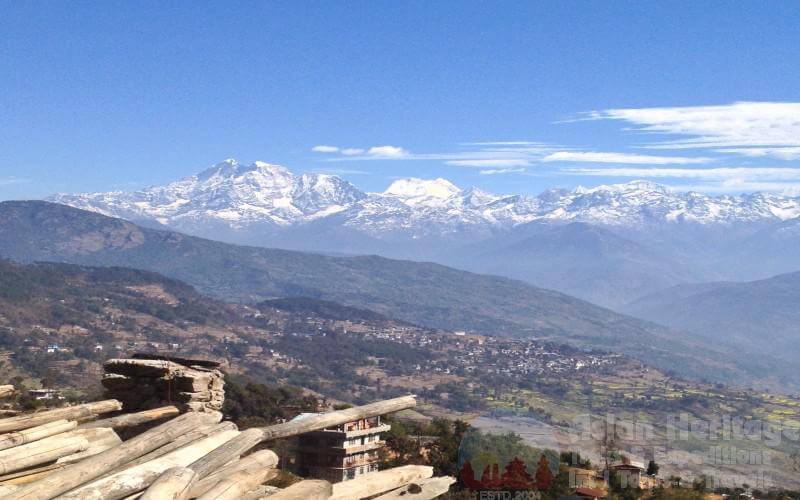Gaurishankar Conservation Area is a protected area located over the Far-Western Region of Nepal. It get its name from the mighty Gaurishankar Mountain that sits within its border. The conservation covers a large area of forested landscapes and encompasses several mountains and hills, with the highest altitude being 6,781 meters above sea level. It covers an area of 2179 sqkm. The conservation area is regarded as a prime habitat for endangered red pandas. It is said that the name Gaurishankar came from the god ‘Shankar’ which is another name of lord Shiva. And his consort ‘Gauri’. It was established in the 1970s and is a protected area of the Himalayas in Nepal. It covers the Ramechhap, Dolakha, and Sindupalchok districts.
The Conservation Area is known for its diverse ecosystem and wildlife and is a destination for nature lovers. The area also hosts several trekking and high-altitude mountaineering expeditions as well as adventure activities like paragliding and rafting. The Conservation Area is also a popular spot for bird watchers and nature photographers, due to the varied biodiversity.
History of Gaurishankar Conservation Area
The history of the Gaurishankar Conservation Area dates back to the 1970s when the Nepal government enacted the first legislation to protect the region from deforestation and overgrazing. The region was declared a Conservation Area in the mid-1970s, aiming to preserve the natural resources and ecosystem, while allowing for the sustainable development of the area.

Over time, the conservation efforts have been fortified with stronger rules and regulations, and the Conservation Area has been declared a World Heritage Site by the United Nations World Heritage Committee in the late 2000s.
Quick Facts about Gaurishankar Conservation Area
- Gaurishankar Conservation Area is one of the largest protected areas in Nepal, covering an area of 4081 square kilometers.
- The Conservation Area has a diverse landscape, with steep mountains, deep valleys, and dense forests.
- The Conservation Area serves as a habitat for a diverse ecosystem, with a range of flora and fauna.
- Due to its biodiversity and sheer beauty, the Conservation Area is a major tourist destination in Nepal.
- The Conservation Area is a hotspot for trekkers and high-altitude mountaineers.
Flora and fauna
The conservation area is rich in bio- The conservation area is home to a wide variety of flora and fauna, including many endangered species. The area is characterized by rugged terrain, deep gorges, and dense forests that provide habitat for a diverse range of wildlife.

The Gaurishankar conservation area is the habitat of species and plants in a diverse range. The conservation area has 14 species of snakes, 16 species of fish, 235 birds, 10 species of amphibians, and 8 lizard species. In the Gaurishankar conservation area, 16 varieties of vegetation have been identified. 34 species of mammal including snow leopard, Himalayan black bear, and Himalayan Thar. List of some animals found in the Gaurishankar conservation area like
- Snow leopard
- Himalayan musk deer
- Red panda
- Asiatic black bear
- Himalayan thar
- Yellow-throated marten
- Himalayan serow
- Red fox
Things to do
Here are some activities that you can explore in the Gaurishankar Conservation Area:
1. Treks and Trails: The Conservation Area has several well-established trails. A popular one is the Gaurishankar Circuit Trek, which provides a challenging and breathtaking trekking experience.
There are adventure treks too offered by Gaurishankar, trails like the Tasilapcha trek or Tsorolpa trial along glacial lakes, and some of these lakes are famous destinations for pilgrimage trekking trials. Once a year on the occasion of the Janaipurnima festival, these holy lakes are visited by thousands of local people.

After the announcement as a conservation area, the region is being explored by camping trekkers. Jatta Polahari camping trek, Dudh Kunda Lake trek, and Tso Rolpa Lake are some of the trending camping trekking activities inside the Gaurishankar conservation area.
2. Paragliding: The Conservation Area provides a perfect launchpad for paragliding. The steep inclines coupled with the high altitude and strong winds make it an enthralling and adventurous activity.
3. Camping: The Conservation Area has a number of camping spots within the region. Visiting campers get to experience the wilderness and explore the region while staying
Places to visit
The Gaurishankar Conservation Area is a stunning protected area located in the northeastern part of Nepal, renowned for its breathtaking mountain scenery and rich biodiversity. Here are some of the top places to visit within the Gaurishankar Conservation Area:
Also Read: Things you don’t know about Khaptad National Park
- Ganja La Pass (5,122m): This high-altitude pass offers spectacular views of the majestic Gaurishankar Himal (7,134m) and other towering peaks. Trekking to the pass is a challenging but rewarding experience for avid hikers and mountaineers.
- Tso Rolpa Lake: This glacial lake, located at an altitude of 4,580m, is considered one of the highest lakes in Nepal. It’s surrounded by towering peaks and glaciers, making for a stunning natural setting.
- Rolwaling Valley: This pristine valley is home to the Rolwaling Himal range and offers excellent opportunities for trekking and exploring traditional Sherpa villages.
- Beding Village: Known as the gateway to the Rolwaling Valley, Beding is a charming Sherpa village with a rich cultural heritage and stunning mountain views.
- Singati: This village is the starting point for treks into the heart of the Gaurishankar Conservation Area. It offers a glimpse into traditional Sherpa life and provides stunning views of the surrounding peaks.
- Gaurishankar Base Camp: For experienced trekkers and mountaineers, reaching the base camp of the mighty Gaurishankar Himal (7,134m) is a challenging but rewarding endeavor, offering unparalleled views of the mountain and its glaciers.
It’s important that trekking in the Gaurishankar Conservation Area requires proper planning, permits, and possibly the assistance of a licensed guide or porter due to the remote and rugged nature of the region.
Protected Mammals
The Gaurishankar Conservation Area is a protected area located in the Dolakha and Sindhupalchok districts of central Nepal.
Popular: Everything you need to know about Makalu Barun National Park
It is known for its rich biodiversity, including several species of mammals that are protected within the conservation area. Here are some of the protected mammals found in the Gaurishankar Conservation Area:
- Snow Leopard: This elusive and endangered big cat is one of the most iconic species found in the conservation area. The Gaurishankar region is considered an important habitat for the snow leopard in Nepal.
- Musk Deer: This small deer species is known for its musk, which is highly valued in traditional medicine. The musk deer is a protected species in Nepal, and the Gaurishankar Conservation Area provides a sanctuary for this animal.
- Himalayan Tahr: This wild goat species is found in the high-altitude regions of the Gaurishankar Conservation Area. It is a protected species in Nepal due to its declining population.
- Himalayan Black Bear (Ursus thibetanus): Also known as the Asiatic black bear, this species is found in the forested areas of the conservation area.
- Red Pand: This unique and endangered mammal is found in the temperate forests of the Gaurishankar region.
- Himalayan Musk Deer: Another species of musk deer found in the conservation area, this species is also protected due to the high demand for its musk.
- Himalayan Goral This small goat-antelope species is found in the rocky areas of the Gaurishankar Conservation Area and is protected within the park.
- Serow: This Asian goat-antelope is found in the forested regions of the conservation area and is a protected species in Nepal.
These are some of the notable protected mammal species found in the Gaurishankar Conservation Area. The conservation area plays a vital role in providing a safe haven for these species and preserving the biodiversity of the region.
Protected Birds
These are just a few examples of the protected bird species found in the Gaurishankar Conservation Area. The area plays a crucial role in conserving these species and their habitats within the Himalayan region of Nepal. It is home to a diverse array of bird species, many of which are protected under various conservation laws and regulations. Here are some of the protected bird species found in the Gaurishankar Conservation Area:
- Himalayan Monal (Lophophorus impedance): This large, colorful pheasant is the national bird of Nepal and is protected under the National Parks and Wildlife Conservation Act of Nepal.
- Satyr Tragopan (Tragopan satyra): Also known as the Crimson Horned Pheasant, this species is listed as Near Threatened by the IUCN and is protected in Nepal.
- Cheer Pheasant (Catreus Wallichii): This striking pheasant species is classified as Vulnerable by the IUCN and is protected in Nepal.
- Ibisbill (Ibidorhyncha struthersii): A unique wading bird found along the rivers and streams of the Himalayas, the Ibisbill is classified as Near Threatened and is protected in Nepal.
- Speckled Wood Pigeon (Columba Hodgsonii): This pigeon species is listed as Vulnerable by the IUCN and is protected in Nepal.
- Lammergeier (Gypaetus barbatus): Also known as the Bearded Vulture, this large vulture species is classified as Near Threatened and is protected in Nepal.
- Blood Pheasant (Ithaginis cruentus): This pheasant species is listed as Near Threatened by the IUCN and is protected in Nepal.
- Himalayan Griffon (Gyps Himalayensis): This vulture species is classified as Near Threatened and is protected in Nepal.
Climate at Gaurishankar Conservation Area
This region is part of the high Himalayas and is characterized by an alpine climate.
You may also like: What you need to know about Nepal’s New Trek, Mundhum Trek
- Very cold temperatures: Given the high altitudes, ranging from around 2,000 meters to over 7,000 meters, temperatures are very low. Average temperatures can be below freezing for much of the year.
- Low precipitation: This is a rain-shadow area on the northern side of the Himalayas. Total annual precipitation is generally low, around 500-1000 mm.
- Dry and windy: The air is very dry, and high winds are common due to the mountain topography.
- Large diurnal temperature range: There are dramatic temperature swings between day and night due to the thin atmosphere and lack of cloud cover.
- Seasonal variations: Winters are extremely cold and dry, while summers are relatively warmer with occasional rain/snowfall from monsoonal influences.
- Permanent snow and glaciers: Above around 5,000 meters, there is permanent snow and ice cover on the mountain peaks and glaciers.
It is a classic high altitude, alpine semi-arid climate dominated by low temperatures, low humidity, high winds, highly seasonal weather patterns dictated by the massive Himalayan ranges. Biodiversity has adapted to survive these harsh conditions.
Let our expert team at Asian Heritage Treks and Travel take care of everything — from guided tours to personalized packing tips and travel arrangements.
Plan My Nepal Trip







